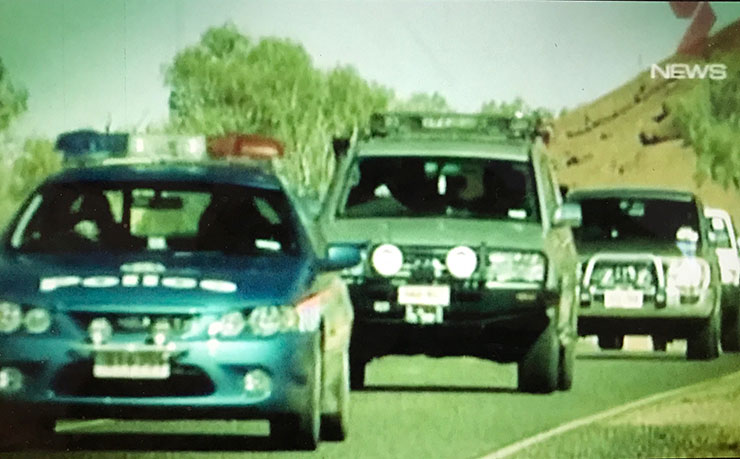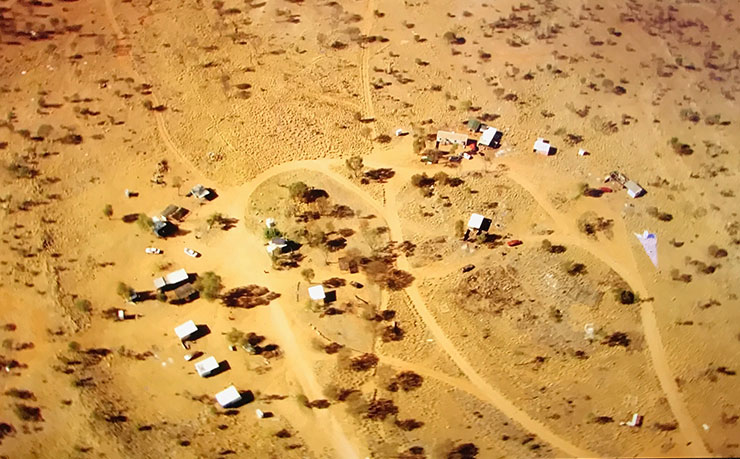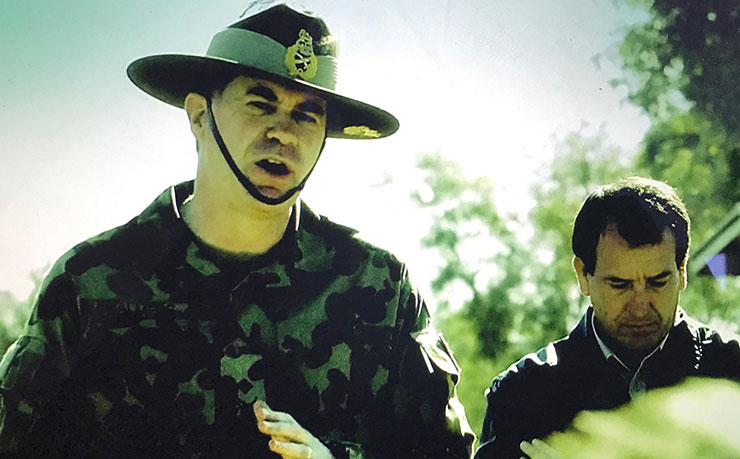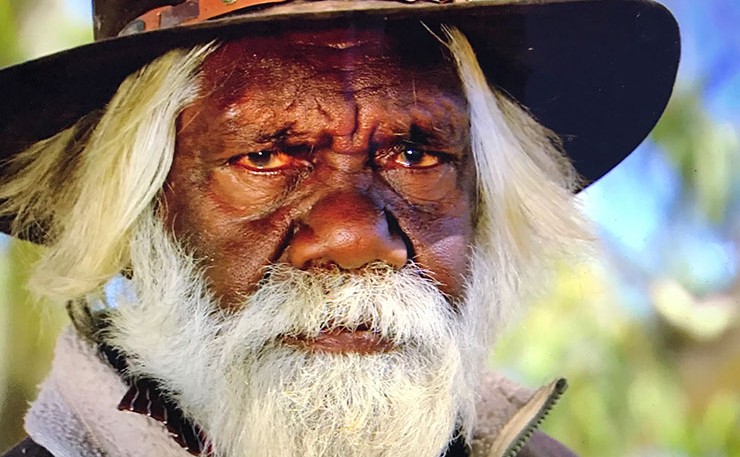A decade ago, they sent the Army in, and made things demonstrably worse. Professor Jon Altman wonders where to from here.
The 10th anniversary of the Northern Territory National Emergency Response, the Intervention that was militaristically launched with extraordinary media fanfare on 21 June 2007, has come and gone. I wondered what sort of response this anniversary might elicit?
The answers to this question are threefold.
First, the mainstream media provided almost zero coverage of the anniversary, or of the many events in the Northern Territory and in southern capital cities where people demanded an immediate end to the discriminatory Stronger Futures in the NT laws which continue key aspects of the Intervention until 2022.
This lack of attention is paradoxical because there was so much media attention focused on the Intervention in its early days; and one stated government rationale for abolishing the permit system at prescribed communities was to enhance transparency and scrutiny by the media.
Once again remote Australia has become out of sight out of mind.
Second, the Indigenous leadership and intelligentsia and powerful political, bureaucratic and corporate actors have moved on from reflecting on the outcomes of the Intervention, about which I will say more later, focusing instead on the issue of constitutional recognition.
This too is paradoxical and a little disturbing.
An enduring memory for me from June 2007 was of convoys of vehicles as the initial ‘national emergency’ militaristic frontline that rolled into Mutitjulu, the Aboriginal community next to Uluru seeking out alleged paedophile rings that never materialised.

Uluru was also the site of the constitutional recognition summit in May this year that delivered the ‘Statement from the Heart’ that looks to eliminate possibility for any future brutal episodes in Indigenous policy making, like the hastily and ill-conceived national emergency intervention.
As I draft this piece the final report of the Referendum Council has just been publicly released. Its main recommendation is for the establishment of a representative First Nations body that will serve as a voice to the Australian parliament.
The Intervention is only mentioned twice in this report in relation to the removal of ‘race’ powers in the Constitution, and in an aspirational plea for a Bill of Rights to provide a guarantee against future acts of racism that the Intervention’s disempowering measures represented. But neither of these proposals are endorsed and so it remains unclear how an Indigenous advisory body might be empowered to override a bipartisan parliamentary revisiting of some future Intervention.
This is of special concern to Indigenous people in the Northern Territory if the Commonwealth’s constitutional territory powers remain in place and if, as in 2007, racial discrimination laws can be suspended at the whim of the government of the day.
Third are the views expressed by Indigenous community leaders who are also subjects of the Intervention, several whom I heard present views in two events held in Melbourne recently; others recorded and transmitted from Alice Springs and Sydney; and those expressed to me directly in numerous visits I have made to the Northern Territory since the Intervention, most recently in April and July this year.
There is a deep hurt and distress expressed at the sheer brutality of the Intervention process that revived bitter memories for older people of being treated as legal minors by the colonial authorities during the assimilation era, a sense of deep hopelessness and disempowerment, and a sense of injustice that the belief that western norms are superior and need to be adopted by Indigenous people can prevail.
People recognise their vulnerability to unilateral state intervention due to historical and deeply structural factors including a high dependence on the state, the fundamental change of welfare to emphasise ‘mutual obligation’, and the fact that they are black and so susceptible to explicit or implicit personal vilification and institutional racism.
These people are proud, not ashamed, of the fact that they possess different and diverse cultural values from those of mainstream Australians; but they are also aware that such difference and diversity means that universalistic policies devised in Canberra will inevitably be poorly designed for their circumstances.

The people I interact with are angry that such difference and diversity cannot be recognised, acknowledged, accepted and accommodated in the everyday workings of the Australian settler state.
The people I talk to and the places I visit also demonstrate an absence of any developmental progress since the Intervention, indeed there is growing evidence that Indigenous people living in remote communities in the NT have become more deeply impoverished since the Intervention, a perverse and very tragic outcome that attracts little media attention; and little acknowledgment or lament by those who have implemented Intervention and Stronger Futures measures or those outspoken white and black advocates for this paternalistic top down approach who have become strangely silent and conveniently forgetful at this 10th anniversary juncture.
Anniversaries are not the time for selective amnesia but for taking a bigger picture perspective on what has transpired. I want to do this in relation to the issue of poverty alleviation that rightly dominates the international development landscape.
I do this because the Intervention was heavily promoted as a major project of improvement and modernisation. Who can forget Malcolm Brough’s heroic call to ‘Stabilise, Normalise and Exit’ remote NT communities, the delivery of what can be thought of as a domestic ‘Marshall Plan’ to demonstrate the developmental powers of the Australian Government in a jurisdiction where, owing to a quirk of the Australian Constitution, it can intervene directly with no checks and balances.
In the 1950s and 1960s, the Commonwealth government deployed its colonial might in a quest to deliver development to remote Aboriginal communities on gazetted reserved lands.
In the 21st century it looks to deploy neoliberal might to deliver liberal democracy and the free market to remote communities on Aboriginal-owned land, but with greatly enhanced and hugely expensive ministerial and bureaucratic surveillance and control.
Just after the 10th anniversary of the Intervention, the Australian Bureau of Statistics released the second tranche of data from the 2016 Census, the most important source of information about the socioeconomic situation of Indigenous people over time and compared to non-Indigenous Australians.
Unfortunately for my analysis, labour market information will not be processed and available till late October this year. But we already know from a recent OECD Report Connecting People with Jobs (2017) that there is a gap of nearly 50% between the overall employment rate of Indigenous and non-Indigenous people in the NT, with this divergence being even greater in remote communities.
While I have reservations about the utility of such quantitative information to capture many aspects of life that are meaningful to remote living Aboriginal people, it is the main form of statistical picturing deployed by the Australian state and its agents to measure performance.
Since the release of census information on 27 June there has been much mainstream media coverage of many aspects of Australia’s general population; but almost none on what this information tells us about the Indigenous situation in general, and in remote Aboriginal communities.

What I want to do here is focus on just two communities – Papunya in Central Australia and Maningrida in the Top End – to demonstrate what sort of basic analysis is possible to monitor key transformations in the last decade.
I select these two communities for personal and historical reasons.
Papunya was the first Aboriginal community in the NT that I visited in 1977; Maningrida is a community that I have visited on 56 occasions since 1979, most recently this month.
Both communities were established by the Commonwealth in 1959 and 1957 respectively and were colloquially referred to as ‘the Jewel of the Centre’ and ‘the Jewel of the North’: these were to be the two demonstration communities where the Welfare Branch was going to show to all how modernisation and development could and should be delivered.
In 1972, when policy shifted to self-determination, there was overwhelming political acceptance that the colonial development project at these iconic government settlements had failed (but coincidentally both became important hubs for Western Desert and bark painting artistic movements).
From 2004 when ATSIC was abolished and Indigenous Australians lost political voice, the self-determination that had dominated Indigenous affairs from 1972 was proclaimed a failure by the Howard government. It was to be replaced by neo-colonial rule from Canberra, a new social experiment with frightening similarities to the previous failed and highly destructive assimilation experiment also run from Canberra.
In Tables 1 and 2, I provide some publicly available census information on these two places and the outstations in their immediate hinterlands focusing on two things: people’s wellbeing as measured by income and employment (bearing in mind 2016 employment data are not yet available); and people’s physical environment as measured by overcrowding.
These are two key areas where the Intervention set out to make a difference through the provision of 1,756 ‘real’ jobs in government service delivery through the Northern Territory Jobs Package and through the $2 billion National Partnership Agreement for Remote Indigenous Housing in the NT, 2008 to 2018.
The two tables tell a similar dismal story.
INSERT TABLES
Table 1. Papunya and outstations 2006, 2011 and 2016
| Indigenous | Non-Indigenous | |
| 2016 | ||
| Population | 426 | 32 |
| Median personal income | $215 | $1271 |
| Persons per bedroom | 1.9 | 0.6 |
| Weekly rent | $30 | $0 |
| Overcrowded households | 67.7% | 0.0% |
| 2011 | ||
| Population | 456 | 37 |
| Median personal income | $223 | $1263 |
| Persons per bedroom | 2.4 | 1.0 |
| Weekly rent | $50 | $0 |
| Overcrowded households | 50.0% | 0.0% |
| Employment rate | 15.1% | 100.0% |
| Unemployment rate | 46.8% | 0.0% |
| 2006 | ||
| Population | 347 | 24 |
| Median personal income | $196 | $949 |
| Persons per bedroom | 2.3 | 1.1 |
| Weekly rent | $30 | $5 |
| Employment rate | 18.7% | 75.0% |
| Unemployment rate | 16.7% | 0.0% |
Table 2. Maningrida and outstations 2006, 2011 and 2016
| Indigenous | Non-Indigenous | |
| 2016 | ||
| Population | 2369 | 171 |
| Median personal income | $219 | $1506 |
| Persons per bedroom | 2.4 | 1.0 |
| Weekly rent | $63 | $0 |
| Overcrowded households | 79.1% | 0.0% |
| 2011 | ||
| Population | 2304 | 240 |
| Median personal income | $268 | $1167 |
| Persons per bedroom | 2.7 | 1.3 |
| Weekly rent | $60 | $0 |
| Overcrowded households | 82.1 | 1.7 |
| Employment rate | 34.0% | 91.5% |
| Unemployment rate | 23.9% | 0.0% |
| 2006 | ||
| Population | 1904 | 157 |
| Median personal income | $209 | $952 |
| Persons per bedroom | 3.9 | 1.1 |
| Weekly rent | $45 | $0 |
| Employment rate | 26.0% | 95.5% |
| Unemployment rate | 17.2% | 0.0% |
First, Indigenous adults are in receipt of just over $200 a week in communities where basic foods can cost 50% more than in capital cities. They are living in deep poverty.
But what is worse is that when adjustment is made for inflation of 24% since 2006, over the past decade adult median income has dropped significantly, people who survived with income under the poverty line in 2006 are now deeper in poverty after 10 years of Intervention.
This situation can in turn be explained by extremely high unemployment rates and extremely low employment rates.
By the time of the 2016 Census most of the unemployed were participating in the new Community Employment Program (work for the dole 5 hours a day, 5 days a week) that was proving very effective at reducing people’s welfare income with ‘no show no pay’ penalties: about 15,000 jobless in the NT attracted nearly 75,000 penalties in census year 2015/16, with 26-week employment outcomes totalling just 843.
The development architecture of the Intervention and subsequent Stronger Futures was not just impoverishing people but also seeing their relative income (the economic disparity between Indigenous and non-Indigenous community members) increase: from 4.8 to 5.9 times at Papunya and 3.1 to 6.9 times at Maningrida. At the same time, the census indicates that poor Indigenous community members are paying more rent than relatively well-off non-Indigenous people.
On housing, and as the National Partnership Agreement that aimed to deliver about 1,500 new homes ends, reducing overcrowding from 10.7 per house to 9.3 according to the Australian National Audit Office, the situation remains bleak.
In Papunya overcrowded houses needing one or more bedrooms increased from 50% to 68% according to the census, while at Maningrida the rate decreased from 82% to 79% of households. Again, the situation for non-Indigenous residents of these places is markedly different because the employment rate is extraordinarily high, and jobs come with housing.
This pattern is repeated in community after community with depressing similarity, be it Yirrkala, Gunbalanya or Wadeye in the Top End, or Yuendumu or Mutitjulu in the Centre.

Aboriginal readers who might have access to the Internet – ironically another area of extreme disadvantage and disparity – can visit the ABS Community Profiles website to get a sense of what has happened in their home community since the Intervention in 2007.
Most that I interact with are all too aware of their deepening poverty and in many cases periodic episodes of household food shortage, hunger and poor health; and the lack of improvement in their over-crowded housing situations.
This is despite the plethora of expensive Stronger Futures, Intervention Mark 2 measures that are supposed to assist, like the BasicsCard instrument to regulate expenditures and the Community Stores Licencing Scheme that aims to deliver ‘food security’.
The Community Development Program is very effectively killing local initiative, enterprise and entrepreneurship owing to its disincentive to earn beyond Newstart, and its effective penalty regime. At the same time a combination of enhanced poverty and excessive policing of vehicles and guns is limiting access to the means of production and the opportunity to exercise the right to access bush foods for livelihood.
This is not to say that it is all doom and gloom. There is success at remote communities and jobs for rangers, in the arts, in tourism, in pastoralism, in carbon farming and in community service delivery. But having a waged job is the exception, income inequality between Indigenous people is growing and this in turn creates a new set of distributional pressures in domestic situations that remain very kin focused.
The decline in median personal income everywhere provides hard evidence that the abolition of the Community Development Employment Projects scheme has been an unmitigated disaster, redirecting people from part-time community-managed waged work to below award, externally monitored work-for-the-dole that more deeply impoverishes the jobless.
The Intervention legislation of 2007, that continued as Stronger Futures laws from 2012, are a complex set of oppressive and racist laws. The laws were designed to discipline Aboriginal men demeaned by parliamentarians, including by David Tollner and Nigel Scullion from the NT, as violent and dangerous and in need of radical cultural and behavioural modification.
In a highly influential book Lands of Shame: Aboriginal and Torres Strait Islander ‘Homelands’ in Transition (2007) the late neo-conservative economist Helen Hughes looked to influence Minister Brough and senior bureaucrats with neoliberal solutions to deeply entrenched and structural development challenges.
Then the Noel Pearson-inspired and Helen Hughes-advised report From Hand Out to Hand Up (2007) provided design recommendations for the Cape York Reform Project, while also delivering guidance and moral authority to the Intervention’s architects.
And in another influential book, The Politics of Suffering: Indigenous Australia and the end of the liberal consensus (2009) anthropologist Peter Sutton (whose main expertise is in Cape York) argued that the progressiveness of the self-determination era was responsible in large measure for the hyper-marginality of remote communities, culturally maladapted to late modernity.
But the current ‘reality of suffering’ that is the result of a decade of continuing punitive and unproductive ‘neoliberal consensus’ is fast entrenching a disaster, the result of the continual application of suites of measures that constituted the Intervention (and now its aftermath) that are largely unadapted and unabated, despite poor results.
These failures have been documented in independent reviews of measures like income management; in parliamentary inquiries; and in numerous reports from the Productivity Commission, the Australian National Audit Office and the Commonwealth Ombudsman.
As a nation, we debate the need for reform 50 years after the 1967 referendum eliminated any exclusionary references to Aboriginal and Torres Strait Islander peoples, that were purportedly made full citizens and yet were rendered constitutionally invisible.

Ten years ago, Aboriginal people in prescribed communities in the Northern Territory were made all too highly visible as ‘others’ whose behaviour was unacceptable, and who needed to be treated with racially discriminatory impunity as non-citizens.
And still Intervention and Stronger Futures measures persist, a sunken investment of billions in an institutional architecture that is impoverishing and causing harm. Who wants to own up to the errors and the waste? When will the major parties, both now with Indigenous members, abandon the quixotic quest to normalise with sameness Indigenous peoples who are proud of their heritage and their difference; and who will resist with vigour imposed incorporation into the mainstream?
Where to now? How can the emerging governance for destructive dependence be radically shifted so that communities regain control and govern for forms of development that accord with local aspirations in all their diversity? How can the Australian state ever be trusted to deal with its remote-living Indigenous citizens with appropriate poverty alleviating duty of care?
I have a recurring vision of tanks as symbols of destructive military might that Aboriginal people have experienced since 1788, and of settler state power rolling into remote communities. The tanks flatten all existing institutional arrangements in their way, arrangements that have been slowly and collaboratively built over decades, some working well, some still far from perfect.
What happens when these tanks eventually reverse, will flattened people and institutions magically bounce back as is nothing has happened? Will the community organisations that delivered positive outcomes, demeaned as worthless by the Australian state and its compliant supporters, somehow automatically reconstitute? Unfortunately, I do not think so; it could take a long time for diminished local organisational capacity to be repaired.
Australian governments and much of the Australian public seem unaware, uncaring, immune to what is happening out there right now, the growing impoverishment and associated destruction of livelihood, social fabric and cultural and linguistic assets.
Maybe there is not just compassion fatigue born of the failure of the Intervention to deliver, but a growing lack of empathy as the injustice in the NT slips in overall ranking among the many competing uncertainties, injustices and inequalities that abound in the present.
Perhaps after sending in the army we need to send in the peace makers from civil society or from development agencies from outside Australia or from the United Nations to re-establish trust. Only then might a new community-controlled institutional framework become a possibility to ensure the fundamental human rights imperatives of immediate poverty alleviation and livelihood restoration.
* A version of this article was published in Land Rights News – Northern Edition, July 2017.
Donate To New Matilda
New Matilda is a small, independent media outlet. We survive through reader contributions, and never losing a lawsuit. If you got something from this article, giving something back helps us to continue speaking truth to power. Every little bit counts.





